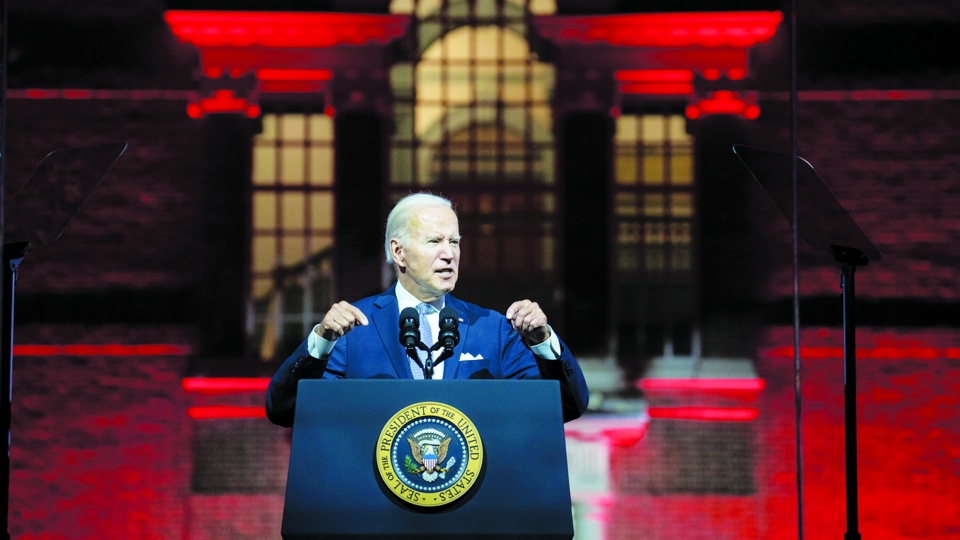
The survival mission of the Democratic Party and the White House
The US midterm elections, which take place every two years in the middle of a four-year presidential term, include votes for all 435 seats in the House of Representatives and about a third of the Senate – 35 seats. There are also contests for governors in 36 states. To have any real impact over the next 24 months, the White House needs Democrats to retain control of the Senate – currently split 50/50.
Maintaining control of the Senate means President Biden can appoint his own nominees to the US Supreme Court if a vacancy arises. These positions must be nominated by the sitting president and then confirmed by the Senate. The US Senate also has the power to ratify international agreements that do not involve foreign trade. This could be significant if there is agreement on a multilateral climate change treaty at next month’s UN conference in Egypt.
Looking back at U.S. history, incumbent presidents’ parties tend to lose in midterm elections. The Democrats under Bill Clinton in 1994 and the Republicans under George W. Bush in 2006 both lost control of Congress, meaning both the Senate and the House. To pass federal legislation, bills must pass both chambers, and that would be nearly impossible if the House were to flip to the Republicans after the upcoming vote.
Above all, the results of the midterm elections will not only determine the future legislative scope of President Joe Biden’s term, but also partly predict whether he will be able to run for re-election in 2024.
According to an analysis by The Washington Post, some 291 Republican candidates on the ballot for the House, Senate and key statewide offices have denied or questioned the results of the 2020 presidential election. If they win the upcoming election, these representatives will have great power over statewide elections, and could choose to reject the election results in their states in 2024.
Pollsters at Gallup, an independent consulting and analytics firm, said this week that President Biden’s Democratic Party is “particularly vulnerable” in the November vote because the national mood is “as bad, if not worse” than in any midterm election in recent years.
Ahead of next week’s election, Mr. Biden’s approval rating sits at 40% — the second-lowest for a pre-term president in nearly 50 years. Gallup notes that an incumbent president’s party has always lost seats in midterms when his approval rating is below 50%, losing an average of 37 seats since 1946.
The Gallup poll also found a new record low in American voters’ satisfaction with the way things are going in the country ahead of the midterm elections, with just 17% of respondents saying they are satisfied. That’s 5 percentage points lower than the previous record low of 22% in 2010, under Barack Obama.
Nearly half (49%) of voters surveyed in a Gallup poll described the state of the US economy as bad, with just 14% describing it as excellent or good, and 37% saying it was stable. The 35-percentage-point gap between positive and negative assessments of the economy is the widest gap Gallup has ever recorded.
“Economic ratings tend to have less to do with midterm election results than other mood indicators, although views of the economy certainly influence how Americans rate the job political leaders are doing, and whether they are satisfied with the way things are going domestically,” Gallup experts Jeffrey Jones and Lydia Saad wrote in a November 1 poll.
Paving the way for Donald Trump’s return?
Despite the poor presidential numbers and voter sentiment, Democrats believe they still have some momentum ahead of the November election. Gasoline prices have cooled significantly from their summer peaks, and employment is rising, which could help ease voters’ concerns about a potential recession.
Polls from September 2022 also show that Democrats have grounds to hope that they can win a majority in the Senate. In Arizona and Pennsylvania, Democratic candidates lead their Republican opponents by as much as 4 percentage points. In North Carolina and Ohio, Democrats are at the top, while the gap in Georgia remains extremely tight.
But in October, Republicans saw the polls flip in their favor. For example, the Senate race in Nevada—which was a surprise upset in September—is now back in the red. And there’s still the looming shadow of Biden’s predecessor: Donald Trump.
This is the first national election in the US since January 6, 2021, when thousands of Trump supporters attacked and occupied the Capitol building, while many Republican politicians following “Trumpism” are candidates in the midterm vote.
The results of the midterm elections could set the stage for Mr. Trump to announce his second White House bid. In fact, Mr. Trump has also campaigned to oust the Republicans who voted to impeach him in February 2021, as well as loudly endorsed candidates who support him. He is estimated to have won 91% of the primaries so far.
A recent PBS NewsHour/NPR/Marist poll found that nearly 70% of Republicans would continue to support Trump. However, only 28% of independents would support him in the 2024 presidential election, and more than 60% of Americans overall oppose Trump becoming the owner of the White House for a second time.
As if identifying the great danger posed by his predecessor, during the midterm elections, President Biden has shifted from a pledge to heal a divided America to a message condemning Trump and his supporters as “extremists”. Calling this a “get-out-the-vote tactic” of the White House owner, David Barker, a professor of government at American University in Washington, told Nikkei Asia that Trump’s outsized influence over the Republican Party gives him a status “like an incumbent president”.
“American voters have Biden, but they also have Trump — which is the fear of Democrats, and even some traditional Republicans who are not Trumpists — who are terrified of the prospect of Trump returning to the White House,” Professor Barker argued. “So Democrats now actually have the same incentives to vote in the midterms as Republicans… making it more like a presidential election than a congressional election.”
The 2022 US midterm elections are shaping up as a rematch between President Joe Biden and his predecessor Donald Trump.





